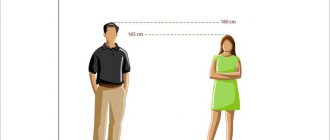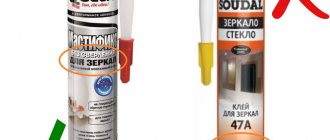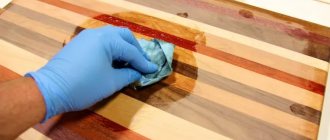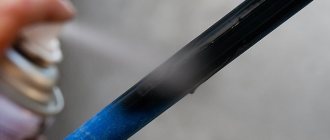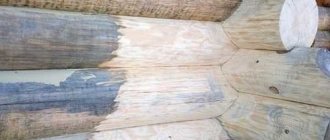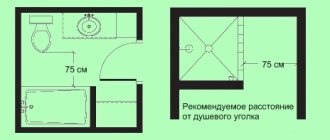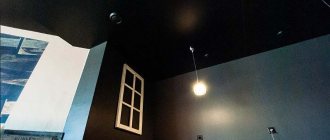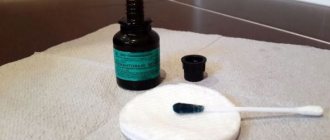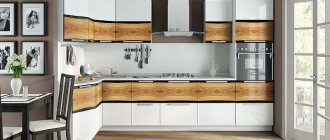During repairs and proposed paintwork, it is important to calculate the required amount of paint. Despite the information indicated on the packages, the amount of composition may depend not only on the type of enamel, but also on the type of surface. Therefore, in order to correctly determine the consumption of acrylic paint per 1 m2, you need to know the general principles of calculation and what types of surfaces and coatings there are.
Accordingly, different types of paints can be used to paint different surfaces. For example, when painting ceilings, a water-dispersed acrylic composition is most often used. Wood and metal surfaces are treated with various enamels. For facades, special compounds are used that are resistant to water and temperature changes. Some of the most effective formulations for application are powder-type compositions.
In order to calculate everything correctly and save yourself from the need for a second trip to the store, you first need to know the paint consumption rates, depending on its composition.
Composition and features of acrylic paint
Usually, for repairs, an aqueous dispersion based on polyacrylates (polymers) is purchased. This composition is used for interior and exterior work. It is diluted with water and has no unpleasant odor or toxic substances. The dispersion has a white color, creamy consistency, and when pigment is added, it can be tinted to any shade. It is applied to the base (dry and prepared) in liquid or paste form.
Painted surfaces dry very quickly (in 3-4 hours). Acrylic does not form cracks and does not require fixatives or varnishes. The water evaporates, leaving a polymer base (an elastic and durable film) on the painted surface, which is not washed off with water, does not fade in the sun, does not wear off for a long time and has a matte shine.
Acrylic paint can be used to paint walls plastered with gypsum plaster, non-woven wallpaper, wooden floors, concrete surfaces, furniture, and doors. Acrylic fits well on brick, wood, plastic, glass, metal, ceramics. Fresh dispersion can be easily wiped off with a cloth, but after drying, a special solvent will be needed to remove stains.
Before using acrylic, the surface must be cleaned of dirt, dust, and grease. It is recommended to level out unevenness using plaster. For better adhesion, it is advisable to treat the base with a primer (also acrylic). If the composition is too thick, it can be diluted with clean water. The dispersion is applied to the wall in 1-3 layers using a brush, roller, foam sponge, spray gun, or sprayer. It is recommended to carry out painting at a temperature not lower than 10 degrees Celsius.
Application of PF 115
What is primer-paint
Main advantage
PF 115 enamel in its versatility. Experts classify this substance as a paint and varnish for use on all surfaces. That is why it has earned particular popularity in the building materials market.
It is possible to combine enamel with other coating agents, such as primer. After application, the coating is not subject to spreading or smearing.
It forms a dense film
with a smooth finish.
The name of the enamel begins with the abbreviation PF, which stands for pentaphthal or alkyd-based resin.
This type is used when working
:
- external type with finishing;
- for covering various types of surfaces: metal, wood or plastic;
- for carrying out work in the interior of the room.
This type of enamel can withstand high atmospheric loads
, such as snow, rain and the effects of low and high temperatures. That is why it is widely used both in home painting and in external work.
The application of enamel to the surface to be coated can be done using an ordinary brush, dipping or pouring. Spraying is also allowed if a special apparatus is available.
In the composition of the substance
contains the following components:
- Pentaphthals
, which experts classify as polymer substances. - Resins
produced by various, including modified, methods. They allow you to speed up the drying process of the surface. - Semi-dried
and resins with special composite mixtures in small quantities.
How to calculate area correctly
Before you buy a composition with acrylic, you need to calculate the area of the surface to be painted. To do this, you need to know only two quantities - length and width. To measure the surface to be painted, use a measuring tape or tape measure (metal or plastic). The area is found like this: the length is multiplied by the width (S=A*B). The calculation is made in square meters, since this is the value indicated on the banks.
See also
Types of paints for decking boards and how to choose, application order
If you need to paint a wall with openings for windows and doors, then measure the total area and area of each opening. Of course, it is recommended to adjust (reduce) the consumption of acrylic for such a surface. This is done like this: the area of all openings is subtracted from the total area.
The consumption of a composition with acrylic for painting architectural elements (columns, niches, protrusions) is calculated by measuring the length and width of each. Then the total area is calculated, consisting of the sum of the areas of the surfaces being prepared for painting.
Construction of houses, renovation of apartments
If there are several foremen working at the site, then a report is kept either for each foreman according to the type of work assigned to each foreman, or for the senior foreman.
For each case of overspending or savings, the financially responsible person must draw up an official note explaining why this happened.
Often the financially responsible person explains the savings in materials by the fact that the material was received and put into the case, but the primary documents for the receipt were not received, were not processed by the supplier, or were lost. In this case, the accounting department must have the necessary document.
Sometimes savings on one material are explained by overuse of another.
This explanation can be accepted if the following conditions are met:
1. Replacement is carried out with a material close to the original in terms of functionality.
2. The use of another material does not violate the technology of work or the load-bearing capacity of the building.
3. There cannot be savings for commercial mixtures containing a binder - cement. For the same reason, the foreman cannot have a commercial mixture containing cement on his report.
Recycling act. In cases where materials are manufactured under construction conditions.
Consumption rates
Manufacturers of acrylic compositions indicate on the label the consumption of their products per square meter. The generally accepted norm is 150-250 grams (glass) per 1 m2. True, most often the label indicates how much area can be painted with one liter of acrylic dispersion. Usually 1 kg of paint is enough for 6-8 square meters.
Expert opinion
Zakharova Irina Yurievna
Cleaning professional with 15 years of experience. Our best expert.
Ask a Question
Acrylic consumption depends on the tool used to paint the walls, as well as on the number of layers and the quality (porosity, roughness) of the base.
Covering power
This characteristic depends on the additives, and which component determines the basis of the coloring agent. By summing up the sizes of all working areas, you can calculate the consumption of the selected finishing product. Dulux and Tikkurila brands are expensive, but more economical. Just one kg of water-based product can cover a fairly large surface. NTs-132 and PF-115 form a strong film on it, but per square meter. m their consumption will increase. The consumption of acrylic paint directly depends on the density of the consistency and its composition.
Factors influencing the final calculation
In order to correctly calculate the consumption of acrylic composition, you need to take into account several important factors. After all, paint is applied to surfaces of varying porosity, using different tools, and not always in one layer. All these nuances need to be taken into account before starting repairs.
Application method
Paint is applied to the walls using various tools: brush, roller, spray gun. The thinner the layer, the greater the savings in composition with acrylic. The most economical method is spraying with a spray gun. If using a roller, it is better to buy a short-haired tool. It is more economical in terms of acrylic consumption.
Base
Any surface can be painted with acrylic composition. When painting a smooth and primed wall, the consumption is minimal. Most acrylic is spent on painting porous, rough, untreated surfaces (brick, stone, cinder block).
Number of layers
Typically, surfaces are painted with acrylic dispersion in 2 layers. In rare cases, this value is 3 or 5. The main thing is to remember that each new layer requires at least half of the established amount of paint. If for the first time you need to paint 1 sq. meter of base, 250 grams of acrylic were used, then the second time you need to spend another 150 grams. In total, 2 layers will take 400 grams.
See also
Reasons and how to avoid the appearance of paint smudges, how they can be removed
Beautiful examples
In the recent past, plaster was used only to level walls. Now interior designs are replete with beautiful examples of painting plastered surfaces.
One common application is to paint plaster in two colors. To do this, you can combine two neutral colors, for example, white and black.
A gradient in an interior looks very beautiful and stylish when shades of the same color palette of different saturations are combined.
Often, bright colors such as rich turquoise or burgundy are chosen for the base layer, and a gold and bronze coating is chosen as the second layer.
First, one tone is applied to the surface using a roller, leaving it to dry for 2-3 hours. After a while, apply a second one, barely touching the protruding areas of the coating.
To simplify the painting process, you can add a color of the selected shade to the plaster solution.
How to calculate correctly
Before you buy acrylic dispersion, you need to calculate the area to be painted. Then it is recommended to evaluate the quality of the base. If the surface is smooth, even and primed, then you will need the minimum amount of paint specified in the instructions.
It is important to decide how many layers of dispersion will be applied to the base. The final paint consumption per 1 m2 depends on this value. When painting a wall in 2 layers, you need at least 400 grams of dispersion per square meter.
If the consumption rate on the label is indicated in liters per room area, then you need to take into account the size of the surface to be painted and the number of stains. It is also advisable to take into account the quality of the tool that will be used for painting. It is best to buy acrylic paint with a reserve.
Examples of paint calculations per 1 square meter of surface
The calculation consists of 3 stages: measuring the dimensions of the surfaces to be painted, calculating the area, determining the consumption based on the paint coverage indicators from the manufacturer, adjusted for working conditions. For clarity, example No. 1 is provided. The walls of a 5x6 m room with a ceiling height of 250 cm will need to be painted.
Calculation algorithm:
- The surface area minus window and door openings will be: S=S1−S2−S3. Total S1=(5+6)*2.5=55. Two windows S2=2*1.5*1.2=3.6. Doors S3=2*2*0.7=2.8. Result: S=55−3.6−2.8=48.6 m².
- The hiding power of the paint according to the information on the packaging is 16 m²/l.
- The requirement for color according to the standard is 48.6/16 = 3.1 l.
- Adjustment for tool: when working with a roller, the flow rate increases by 10%. You need to purchase 3.1*1.1=3.4 liters or 3.4*1.5=5.1 kg.
Example No. 2 differs in the use of the norm in kilograms per unit area. If the packaging indicates 0.15 g/m², the basic requirement for the previously calculated area will be 48.6 * 0.15 = 7.3 kg. With the adjustment for the spray gun, 5% is added, total: 7.7 kg.
Calculation examples
Any surface can be painted with acrylic composition. Each base has its own consumption rate. The least acrylic is consumed on a smooth and primed wall.
For non-woven wallpaper
Non-woven wallpaper previously glued to the wall can be painted with acrylic. For painting, a roller with short or medium pile is usually used (the optimal size of the pile is 5-10 mm). One square meter of area will require 200-250 grams of dispersion.
During facade work
The external walls of the house can also be painted with acrylic dispersion. For this type of painting, they buy a composition that says “for facade work” on the label. Typically, 180-200 grams of acrylic are used per square meter of area.
The surface to be painted must first be prepared, thoroughly leveled and primed. Painting an unprepared brick wall will require more paint (200-250 grams per 1 square meter). Once every 3-4 years, it is recommended to refresh the façade painted with acrylic. It is not advisable to buy paint in advance (in reserve). After all, the shelf life of acrylic dispersion is no more than 2-3 years.
Acrylic-based textured paints
Textured (structural) compositions with acrylic help create a relief or textured surface. Of course, the consumption of such material will be large. After all, the technology for applying a texture composition is not simple. First, the structural material itself is applied to the wall, and then, using tools, a decorative relief is created. Usually per 1 sq. per meter of area, 0.5-1.2 kg of textured mixture is consumed.
Painting in 2 layers
In the previous section it turned out that two-layer painting increases paint consumption, but is not always expensive. The purpose of double painting is obvious - to smooth out the supporting base and create a finished background. Moreover, a brush is used for smoothing, and a roller is used for finishing painting.
The second layer can be abandoned in the following cases:
- Reliable silicone or alkyd paint is used for painting;
- The supporting base itself is smooth and even;
- The material of the supporting base does not rot or rust;
- The first layer covers the surface perfectly.
It is very important to pay attention to the effects of temperature and moisture. If the base goes outside, then by default it must be painted in two layers.
Final tips
- Clean the area thoroughly before painting, as each defect will lead to an increase in the working area.
- Use special impregnations at the preparatory stage
- Use a painting tray; you can press the roller in it on a special field.
- Bitumen varnish - characteristics, application, properties and options for applying the composition (100 photos)
- How to remove old paint - the best ways to remove a layer of paint from walls, ceilings and floors (75 photos)
- How to paint walls: tips for choosing colors and shades for walls. Detailed instructions on how to properly apply paint yourself
Now that calculating the preliminary volume of paint is no longer a sealed secret, you can safely go to the supermarket, buy paint and bring all your design fantasies to life. Good luck.
Why do you need a primer?
The material is intended to strengthen surfaces, as well as to improve their density.
Primer helps you save money by using less paint or wallpaper paste, as it significantly minimizes the absorption of the material. The primer also has moisture-proof properties and prevents cracks. Several types of primer materials contain antifungal elements that will prevent fungi and bacteria from penetrating the surface. Primer is a great way to preserve your updated home for a long time.
Each primer has its own purpose. Now there are many types of primers for all types of work. These products differ in composition and may include oils, resins, and varnishes. There are primers that are used on wood and metal. There is also a distinction between special and universal primers. Also, priming agents have differences in the degree of viscosity, come in different densities, have different colors and dry at different times.
